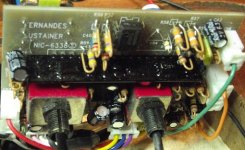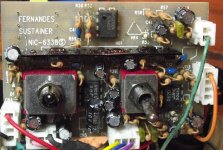So I dabble with guitar sustainers - normally use standard Class AB chip amps (to get a flavour of what I'm up to check out a recent upload of mine YouTube - Rough 'n ready self made Sustainer demo ). Essentially, you take a guitar signal, amplify it & feed the signal into an electromagnetic driverc coil (instead of a speaker), this keeps the guitar's ferrous strings vibrating.
Ok, thesen things being battery powered I thought it might be interesting to explore using a Class D amplifier - epic fail.
Not even a hint of sustain!
I used a MAX9700 as it is touted as filterless (and space is tight in a guitar where the circuit will have to go) - but not even a peep of sustain when I use this setup. Yet if I place a speaker in place of the sustainer driver coil, I can hear stuff coming though loud & clear (meaning the circuit is working)
Now I know it must be possible to get a Class D working with a guitar sustainer (one of the two major commercial sustainer manafacturer's use them), but I'm at a loss why there's be no even a hint of sustain.
Does anyone have any theories or ideas how I can troubleshoot this?
i'm figuring my first port of call would be to get an LC filter on there - at least then I can see what the signal is being applied across the driver coil (becuase without the filter, all I see is the square wave across the driver - which I can't make head nor tail of!)
cheers.
Ok, thesen things being battery powered I thought it might be interesting to explore using a Class D amplifier - epic fail.
Not even a hint of sustain!
I used a MAX9700 as it is touted as filterless (and space is tight in a guitar where the circuit will have to go) - but not even a peep of sustain when I use this setup. Yet if I place a speaker in place of the sustainer driver coil, I can hear stuff coming though loud & clear (meaning the circuit is working)
Now I know it must be possible to get a Class D working with a guitar sustainer (one of the two major commercial sustainer manafacturer's use them), but I'm at a loss why there's be no even a hint of sustain.
Does anyone have any theories or ideas how I can troubleshoot this?
i'm figuring my first port of call would be to get an LC filter on there - at least then I can see what the signal is being applied across the driver coil (becuase without the filter, all I see is the square wave across the driver - which I can't make head nor tail of!)
cheers.
I was thinking exactly about the same. Few days ago I was fixing a guitar with Fernandes sustainer and thought "why don't they use a class-D amp (to a least minimize the size of the board)?". Have you got a schematic of any commercial sustainer? There must be something more than amp in the circuit (e.g. if you switch to harmonics mode).
But I'm not sure what exactly is your problem. You build a sustainer with class AB chip and it works. And you replaced the chip with class D amp and now it does not work? Is the setup of the guitar unchanged? I mean is the driver pickup close enough to strings?
I would start by recording a short sound, looping it and providing the output to the driver (as look what happens). This maybe a problem with lack of filter on the output of the amp. But I would also consider the phase of the signal. If you can observe the signal, most probably you have an oscilloscope. If it's the case, I would quickly add a simple filter of the output and compare the signal with class AB version.
Mark
But I'm not sure what exactly is your problem. You build a sustainer with class AB chip and it works. And you replaced the chip with class D amp and now it does not work? Is the setup of the guitar unchanged? I mean is the driver pickup close enough to strings?
I would start by recording a short sound, looping it and providing the output to the driver (as look what happens). This maybe a problem with lack of filter on the output of the amp. But I would also consider the phase of the signal. If you can observe the signal, most probably you have an oscilloscope. If it's the case, I would quickly add a simple filter of the output and compare the signal with class AB version.
Mark
Last edited:
Check for polarity.
Already done that - I know there's something happening (magnetic drive wise) out of the driver, becuase if I hold my driver over the source pickup - I get squeal, but it ain't sufficient enough drive to move a string!
I'll wind myself a couple of inductors towards putting an LC filter on the output of the Maxim IC - at least then I can see what's going on with the analogue signal as sent to the driver coil (at the minute, I'm completely blind - just square waves with a varying duty cycle).
Markus...no I haven't got a schematic of any commercial sustainer (the sustainer company 'Sustainiac' use a Class D amplifier on their), I just dabble with a simple jfet buffer into a bog standard audio amplifier IC (eg LM386) - it works ok, but it's a bit of a battery hog, hence wanting to get explore Class D.
Last edited:
What about this black module in Fernandes sustainer? Isn't it a class-D amp?
Mark
View attachment 195673
Dunno...that's the first time I've seen one! (is this the one you're fixing? What's the problem with it?)
Certainly those two black lumps look like they could be the inductors for the class d filter.
Maybe. But why? Impedance of typical singlecoils or humbuckers is typically in kOhms range, so the power consumption of "power" amp is comparable what an opamp consumes at idle. I believe you feed the signal back to the transducer which you currently don't use for picking up sound.
The black module looks to me like a thick film circuit with surface mounted components on it. The black lumps are not big enough for inductors but appear to be power transistors.
I cant see any inductors in the picture.
perhaps. But then again, class D amp - BTL variants, can get away with two smaller inductors (eg 16uh), which (certainly in lowish current capablitliies) could be surface mount low profile?
darkfenriz - remember the pickup feeds the sustainer circuit - the device on the output size is akin to a speaker (typically about 8 Ohms impedance)
I agree. It looks like a thick film circiut with SMD components soldered on both sides. The black squares have 8 pins so they are either ICs or MOSFET transistors. There are two on the top and at least one or two on the bottom side.The black module looks to me like a thick film circuit with surface mounted components on it. The black lumps are not big enough for inductors but appear to be power transistors.
I cant see any inductors in the picture.

Can you see it better on this photo?
I was just adjusting the guitar and I don't have it any more. Depending on settings the current consumption is above 50 mA. I think that class D is a must in this case. And the circuit is much more complex that a simple power amp. It has various filters (used in "harmonics" mode) and a negative feedback circuit (when the signal gets higher, the gain of the amp decreases).
Mark
For a filterless class D amp to reconstruct the waveform the inductance of the speaker is essential, also it is possible that the intertia of the speaker cone mass may also be involved in the reconstrunction (this is supposition as I have not tested it). If you are passing this to a low inductance no mass pick up coil that may be your problem.
Using reconstruction inductors and capacitors would both make the signal visible and probably solve your problem.
Regards,
Andrew
Using reconstruction inductors and capacitors would both make the signal visible and probably solve your problem.
Regards,
Andrew
- Status
- This old topic is closed. If you want to reopen this topic, contact a moderator using the "Report Post" button.
- Home
- Amplifiers
- Class D
- Class D amplifier for a guitar sustainer - eh?
